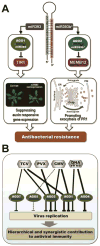Contribution of small RNA pathway components in plant immunity
- PMID: 23489060
- PMCID: PMC3752434
- DOI: 10.1094/MPMI-10-12-0255-IA
Contribution of small RNA pathway components in plant immunity
Abstract
Small RNAs regulate a multitude of cellular processes, including development, stress responses, metabolism, and maintenance of genome integrity, in a sequence-specific manner. Accumulating evidence reveals that host endogenous small RNAs and small RNA pathway components play important roles in plant immune responses against various pathogens, including bacteria, fungi, oomycetes, and viruses. Small-RNA-mediated defense responses are regulated through diverse pathways and the components of these pathways, including Dicer-like proteins, RNA-dependent RNA polymerases, Argonaute proteins, and RNA polymerase IV and V, exhibit functional specificities as well as redundancy. In this review, we summarize the recent insights revealed mainly through the examination of two model plants, Arabidopsis and rice, with a primary focus on our emerging understanding of how these small RNA pathway components contribute to plant immunity.
Figures


References
-
- Baulcombe D. RNA silencing in plants. Nature. 2004;431:356–363. - PubMed
Publication types
MeSH terms
Substances
Grants and funding
LinkOut - more resources
Full Text Sources
Other Literature Sources

